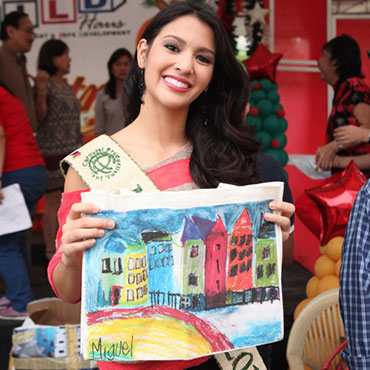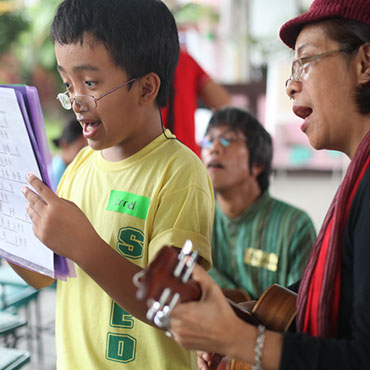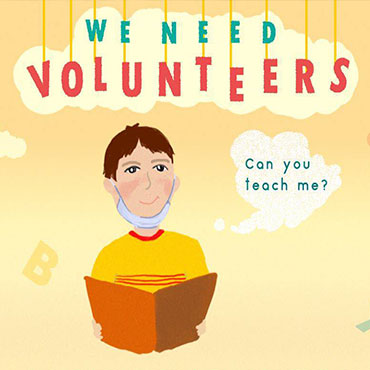Story & Photos by Pilar Fernandez
Carlos Felipe, Nicole Co, and Helena Prudenciado, are artists who have autism. Through their crafts, they express themselves and uplift others.
Carlos, 18, is a self-taught clay artist and learned painter. His artworks depict real or mythical creatures with lively colors and intricate details. Lisha Felipe, his mother, recalled that their family discovered his talent for molding clay at six years old. After a few years, Carlos became engrossed with painting and drawing.
Meanwhile, Nicole has always been a painter and a drawer. Her mother, Grace Co, said the 18-year-old started taking art classes around 10 years ago at the advice of her therapist. Art relaxes Nicole who loves to paint happy children and the places she’s traveled to.
Drawing away from traditional art, Helena, 25, is a digital artist that graduated as an animation student from iACADEMY in 2022. She creates semi-realistic pieces, combining what she calls “crazy patterns” with bright colors.
“Art is about expressing my feelings or getting inspired by what I see, what I hear, what I read,” said Helena.
Since autism is a developmental disability, Carlos, Nicole, and Helena sometimes find it difficult to communicate and manage their thoughts and feelings. Art has then become their safe space. For their mothers, their artworks mean so much more.
“I hope he continues his art” said Lisha, who sees Carlos’ art as his life accomplishment and contribution to society.
“I am so proud [of Nicole] when I look at her work. It inspires me. I know it’s God’s gift to her, and her gift to others.” said Grace.
Arlene Prudenciado, the mother of Helena, said of her daughter's craft, “Parang maliwanag ang buhay[...] ‘pag tinitignan ko.”
Special Achievers, a non-government organization established in 2013 to aid children with disability (CWDs), has been promoting the artworks of Carlos, Nicole, and Helena and 10 more artists through exhibits, campaigns, and merchandise. The 13 artists are set to have a permanent space for their work in Hiraya Gallery starting July, 2022.
“I feel that what we’ve done is really spotlight ability and rally for inclusion,” said Co-founder Karen Navarro.
Beyond Education reported that misconceptions about disability persist, causing Filipino families to hinder CWDs’ growth and societal participation. About 5.1 million children live with impairments according to PhilHealth.
With the brush strokes of their artists, Special Achievers hopes to paint a society that embraces CWDs.

Carlos colors his Piet-Mondrian-like sketch in Young Artists’ Studio, where he has been enrolled since 2017. It was his third drawing session since he had resumed his weekly classes in May, 2022. The drawing classes had been stopped at the start of the coronavirus (COVID-19) pandemic.
His new art teacher has been drawing upside down, so Carlos can mirror her work. He has trouble shifting from three- to two-dimensional thinking.

Lisha places mufflers over her son’s ears to block out the sound of the downpour of rain. Carlos is sensitive to noise, ceasing to color once the rain became heavy during his fourth drawing session. Lisha said that Carlos would not have used the mufflers if he was in the comfort of his home.

Carlos watercolors his sketch of bamboo during his fourth drawing session. The activity is part of his mother’s plan to slowly transition him to painting in the studio. Carlos prefers to have separate spaces for drawing and painting as he has compartmentalized his activities.
Carlos usually paints in the Village Art Gallery, where he has studied since he was 11 years old. However, the studio has halted his weekly painting lessons since 2020 due to the COVID-19 pandemic.

While humming a tune, Carlos spreads acrylic paint over the canvas to make fluid art. Carlos had picked up the art style over the pandemic, making it the third time he has done it. In the past two years, Carlos only once painted an animal: a peacock.
Carlos used to create one painting per week, filling his home with over 300 finished canvases. At that time, his father, Rufy, wanted to keep all his paintings, while Lisha and Pepeton, his older brother, tried to sell or give them away.

Carlos tilts the canvas to fill the corners with paint at his mother’s repetitive prompting. A few minutes later, Carlos stormed of, banging his chair on the ground then closing the glass doors with a bang. He spent the remainder of the afternoon walking around the house and drawing or playing Minecraft in his room to calm down.
Lisha explained that’s how Carlos sometimes releases his emotions. His stress from attending his first face-to-face therapy session in two years earlier had piled up with her “controlling” presence which is why she mostly leaves Carlos alone when he’s creating. In the peaceful silence of their home, she waited by his workspace in case he came back.
“The main goal for Carlos is to be happy. We [have] to detach from the norm. We have to embrace the idea that he is truly different,” said Lisha of learning to follow Carlos’ pace over the years.

Lisha points out the blue swirl around the horn of Carlos’ clay unicorn, admiring her son’s natural eye for detail and color. Carlos took small strips of different clays and rolled them together into the unicorn’s horn. Like always, he chose the colors on his own.
Carlos, who was diagnosed with autism at two years old, molded clay with bare hands. He had begun to play with clay after Pepeton tried to make toys out of it for Carlos. It helped strengthen his motor and sensory skills.
Lisha recalled that Carlos also had an “elephant phase” when most of his artworks would depict elephants. Carlos’ clay creations or “his friends” would later inspire Carlos and Friends, a business that Lisha started in 2012 to earn funds for her son.
Carlos’ skill also caught the eye of occupational therapist Karen Navarro around 10 years ago. He was a patient in a therapy school, and, like the rest of the staff, Navarro watched him mold a new clay animal almost every five minutes. Carlos once sculpted 65 clay creatures in three days.
At Navarro’s request, Carlos was featured in a newspaper article through Special Achievers, beginning Lisha’s and his involvement with the group. For the next two years, Lisha handles the merchandising of Special Achievers’ 13 artists through Carlos and Friends with the help of Pepeton.
Carlos eventually outgrew his clay creations, but his love for animals remains in his visual artworks. “His friends” are kept and treasured by his family.

Nicole erases a part of her sketch of smiling children playing at the beach on May 26, 2022. She is drawing on an illustration board because she ran out of canvases. Beside Nicole, Grace holds a sharpener. Nicole sometimes has a hard time sharpening her pencils, which causes her to throw a tantrum, so her mother does it for her.
Nicole started drawing around four to five years old and likes to depict the places she enjoys. She once painted strawberries to represent the strawberry fields in Baguio and a castle that looked like the one in Disneyland. A lover of the sea and the sand, Nicole and her family will go to the beach for the summer.

Nicole paints her sketch blue after filling in all the red parts. Grace noticed that Nicole’s colors are solid today, different from her usual style of blending paints. Grace often squeezes the acrylic paint tubes for Nicole who tends to empty them out when no one is looking. Nicole also uses too much paint during her art lessons, but she hasn’t met with her art teacher in two years due to the COVID-19 pandemic.

Grace shows an eco-bag designed with Nicole’s artwork of smiling children riding a rollercoaster. Nicole loves roller coasters, once riding one five times in a row.
The eco bag was part of Special Achievers’ Echo Bag campaign in 2013, the group’s first project. The proceeds were given to the artists and to Special Achievers’ Mentorship program which provides free art workshops for CWDs. Nicole modeled for the Echo Bag campaign at the invitation of Karen Navarro who met Nicole and her mother through a therapy school.

Nicole and Grace share a laugh after Grace asked Nicole whether she was happy.
“She’s so innocent. She makes us smile and makes us laugh. She makes us happy,” said Grace.
Grace said her friends and family have always been supportive and open towards her daughter, calling her a blessing. Their warmth helps her understand Nicole better.

Nicole and Grace converse while Nicole pauses from painting.
Nicole didn’t always know how to speak. She was diagnosed with autism at two and a half years old and cried to communicate in the first few years. It had been challenging for Grace––even if she had expected that her daughter was different.
“I was so thankful when she started to talk around seven [years old],” said Grace.
Now, Nicole attends speech therapy. When she can’t express herself verbally, her mother takes cues from her body language to understand what she wants to say.

As the sun begins to set, Nicole colors one of the children’s eyebrows in her artwork dark brown.
Nicole can spend hours doing what she loves, mostly singing and drawing. Grace said Nicole was videoking “songs from the time of her lola” for three hours before painting today. Other times, Nicole plays the piano by ear, bakes with her mother, or gardens with her lola.
Nicole spends the rest of her day doing household chores like folding the laundry, setting the table, and fixing her bed. She also prays daily and knows how to lead the rosary.
Grace is training Nicole to become more independent. Still, she wishes for a long life to take care of her daughter.
“We don’t know what the future holds, but we’re hopeful. Maybe, her mission is just to inspire people, [...] to make others happy,” said Grace.

Arlene shows Helena’s fantastical childhood sketches, calling them her daughter’s first works as an artist. Helena started drawing at the age of three. She would draw everywhere: on the walls, books, and loose papers. She used to have calluses from drawing first thing in the morning every day.
Around the same time, Arlene suspected that her daughter was different. Since disability was an uncommon topic at the time, Arlene’s husband initially refused to believe her, and it was difficult to find a doctor. The signs, however, were there. Helena wasn’t responding to her name and talking as much as other children.
Helena was diagnosed with autism at the age of four. She has been attending therapy and, with the support of her family, has grown into a blossoming artist.

Helena displays an original character she drew for her ongoing passion project and story “Magical Girl.”
“Most of my character designs now are more diverse. I can’t stand all the cookie cutter characters, same face, same eye shape,” said Helena.
Helena’s characters are often inspired by her favorite childhood shows like “Winx Club,” “Cardcaptor Sakura,” and “Magical Doremi.” The fantasy genre and mythology also influence her artworks. If she’s out of ideas, Helena listens to music to spark her creativity.

Helena starts her digital craft accompanied by her dog clothed in pink, her favorite color. She normally draws in her bedroom, but, for the purpose of this project, she worked in her family’s room where she records her song covers.
Helena started digital drawing around 10 years ago. She had briefly taken art lessons, but she disliked doing traditional art and following her teacher. Arlene discontinued her classes with ease, wanting Helena to develop her own art style.
Helena’s creative process has multiple steps. Helena first sketches her concepts on paper, then traces a photo of her drawings on her tablet. Afterwards, she colors her drawings on the computer and uses a digital sketching pen to add details.

Helena draws the eyes of the octopus in her artwork with her Wacom pen. Her drawing depicts patterned sea creatures in the ocean as Helena has been missing her days at the beach. Over the pandemic, creating art has helped Helena remember “the good times.” She and her family plan to go to the beach this summer.

Helena and Arlene search through folders of Helena’s past digital artworks and recall the stories behind them.
One of Helena’s major projects was her thesis “Home, Sea Home,” a 30-second simple animated film about a seahorse that was released into the ocean after being confined in a research center. Helena wanted to make a film related to environmental issues and to obscure, endangered species like the seahorse. She worked on her final project alone, save for her mother proofreading and editing her thesis paper. Arlene has been telling her to practice her animation, but Helena contested that the software is too expensive.
Helena enrolled as an animation student in iACADEMY in 2013. Pursuing college was a difficult decision for Helena and her family because they wanted to preserve her life savings.
Arlene eventually registered Helena in iACADEMY on the condition that she graduates within 10 years. She understood that college was the important thing to her daughter. As Arlene’s office was only two blocks from the academy, her main concern about leaving Helena alone was also relieved.
Helena was initially overwhelmed with the schoolwork, causing her to take a break for a year and a half in her second year. Within that period of rest, she took 6-month courses on art and animation to improve her craft. She began underloading once she returned to iACADEMY and completed her course in nine years.
Aside from developing her artistic skills, Helena’s time in the academy taught her to be more independent. With the help of her parents, Helena learned how to buy her own food, to commute, and to cross the street.
Arlene said that her faith in God made her believe that “things [would] turn out okay” for Helena and that they’d always find the money to continue her education.

Arlene gazes at an artwork Helena made in grade one. She recalled that Helena was instructed to only draw a landscape, so it was surprising when Helena added the figures of two people. It was one of the many times when Arlene realized how talented Helena is. Her daughter would often be awarded the “most creative” in school.
Moving forward, Helena is searching for employment. She dreams of doing graphic art and creating logos for companies. She has been learning how to do interviews and work under supervision to prepare for her future career. She also plans to start taking art commissions with the help of her sister, Angela, who is an animation student in iACADEMY.
To expand her work, Helena is looking into making non-fungible tokens with Special Achievers. Karen Navarro has been one of Helena’s therapists since 2016. She introduced Helena to Special Achievers in 2019.
Knowing Helena’s dreams and the difficulties she may face, Arlene prays for her daughter’s future.
“Even if it’s a small good thing that happens to her, it’s enough for me,” said Arlene.




